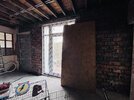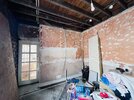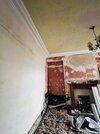There are similar threads to this one I know, but not quite what I’m looking for… anyone out there who does this as a job can give advice??
I’ve bought a Victorian terraced house with rat trap bond brick walls - lime plastered and dashed externally. The walls are ok, no damp and have very thick, old lime plaster which hasn’t blown anywhere. Since we took the wallpaper off, I can see over the years the walls have been filled, sanded, painted with black jack painted upto 1.2 (not sure if this was just a prevention thing back then or if they actually had damp at some point). There are patches of modern day plaster in some areas, including the ceilings. We’ve taken up the floorboards, all ok underneath, good ventilation, no signs of damp, dry joists so all good. We’ve put in a new French door with trickle vents.
A plasterer who does both modern and lime has come in to quote and recommended gypsum because there are no signs of damp, the walls are dry and it will be ok to do, but I’m not sure, this advice feels wrong but surely if he was out to make money, he’d suggest lime… I’m torn… he sort of suggested that because the walls have normal cement (with lime) externally, then it won’t need it inside… as the wall is breathing with minimum moisture coming through, but again this feels wrong. Patches of modern day plaster have surely ruined the breathability of the lime - yes there are no issues currently, but the room was covered in wallpaper which I’m told was painted every 6 months (the elderly guy living here used to get the painters in for company!) so hard to tell if there were any issues. As the walls seem ok, My gut is saying try painting them first to see if they come up ok … but then to I get normal paint or clay / mineral? But what’s the point on the normal patches of gypsum?! Plus it will be difficult to paint over the blackjack… do I just plaster first as last … but which one?! I also have the kitchen to do - that has been hacked back to the brick. I’m thinking there will be so much moisture in the kitchen, I should def use lime - but again he suggested gypsum would be ok?? Photos attached for reference.
I’ve bought a Victorian terraced house with rat trap bond brick walls - lime plastered and dashed externally. The walls are ok, no damp and have very thick, old lime plaster which hasn’t blown anywhere. Since we took the wallpaper off, I can see over the years the walls have been filled, sanded, painted with black jack painted upto 1.2 (not sure if this was just a prevention thing back then or if they actually had damp at some point). There are patches of modern day plaster in some areas, including the ceilings. We’ve taken up the floorboards, all ok underneath, good ventilation, no signs of damp, dry joists so all good. We’ve put in a new French door with trickle vents.
A plasterer who does both modern and lime has come in to quote and recommended gypsum because there are no signs of damp, the walls are dry and it will be ok to do, but I’m not sure, this advice feels wrong but surely if he was out to make money, he’d suggest lime… I’m torn… he sort of suggested that because the walls have normal cement (with lime) externally, then it won’t need it inside… as the wall is breathing with minimum moisture coming through, but again this feels wrong. Patches of modern day plaster have surely ruined the breathability of the lime - yes there are no issues currently, but the room was covered in wallpaper which I’m told was painted every 6 months (the elderly guy living here used to get the painters in for company!) so hard to tell if there were any issues. As the walls seem ok, My gut is saying try painting them first to see if they come up ok … but then to I get normal paint or clay / mineral? But what’s the point on the normal patches of gypsum?! Plus it will be difficult to paint over the blackjack… do I just plaster first as last … but which one?! I also have the kitchen to do - that has been hacked back to the brick. I’m thinking there will be so much moisture in the kitchen, I should def use lime - but again he suggested gypsum would be ok?? Photos attached for reference.




